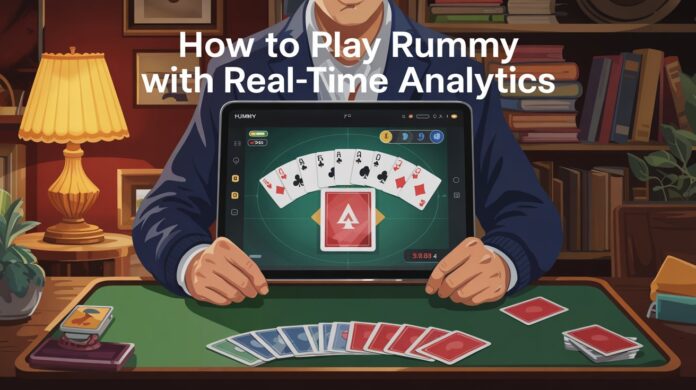In today’s fast-paced digital age, even classic card games like rummy are being transformed by technology. Combining the strategic depth of rummy with the power of real-time analytics can take your gameplay to the next level. Whether you’re a seasoned player or a newcomer to the game, integrating real-time data into your strategy can help you make smarter moves, manage risks, and ultimately win more games. In this comprehensive guide, we’ll explore how to play rummy using real-time analytics, delve into the benefits of a data-driven approach, and provide actionable tips and strategies to help you excel at the game.
Rummy and Real-Time Analytics
Rummy has been a beloved card game for generations, renowned for its blend of luck, skill, and strategy. Traditionally, players have relied on intuition, memory, and experience to outmaneuver their opponents. However, with the rise of digital platforms and advanced analytics, players now have the opportunity to incorporate data-driven insights into their gameplay.
Real-time analytics involves processing and analyzing data as it is generated. When applied to rummy, it means tracking game events, player behavior, and card distribution patterns in real time to make informed decisions. This blend of traditional card game strategy and modern data science creates a unique edge for players who want to optimize their moves and elevate their performance.
Understanding the Basics of Rummy
Before diving into the world of real-time analytics, it’s essential to understand the game itself. Rummy is a group of matching-card games that involve forming sets or runs of cards. Here’s a quick overview of what you need to know:
What is Rummy?
Rummy is a popular card game that involves forming valid sets and sequences with the cards in your hand. The primary objective is to organize your hand in a way that minimizes deadwood (unmatched cards) and maximizes your points by melding cards into valid combinations. With variations such as Indian Rummy, Gin Rummy, and others, the fundamental rules remain similar, though the scoring and specific gameplay mechanics might differ slightly.
Essential Rules of the Game
While the exact rules may vary by variation, here are some core concepts that apply to most rummy games:
-
Dealing Cards: Each player is dealt a set number of cards from a shuffled deck.
-
Objective: Form sets (groups of cards of the same rank) or runs (sequences of consecutive cards of the same suit).
-
Discarding: Players draw and discard cards with the goal of reducing unmatched cards in their hand.
-
Winning: The game continues until one player has successfully arranged their hand into valid combinations, thus declaring a win or “going out.”
Understanding these basic rules is crucial before adding a layer of complexity with analytics. Once you’re comfortable with the game, you can start harnessing the power of real-time data to refine your strategy.
The Evolution of Rummy in the Digital Era

With the advent of the internet and mobile technology, rummy has transcended traditional table settings to become a digital pastime enjoyed by millions worldwide. Online platforms now offer a host of features that allow players to track their statistics, analyze past performances, and even play in live tournaments.
Digital rummy games have not only made the game more accessible but have also introduced the possibility of real-time analytics. Platforms equipped with advanced algorithms can track every move, monitor game trends, and provide insights that can help players adjust their strategies on the fly. This evolution is a testament to how traditional games can adapt and thrive in a data-centric world.
What is Real-Time Analytics?
Real-time analytics refers to the process of collecting and analyzing data immediately as it is generated. This allows for instant insights and quick decision-making. In the context of rummy, real-time analytics can track every card played, analyze patterns, and provide recommendations based on historical data and current game dynamics.
How Real-Time Analytics Works
At its core, real-time analytics involves:
-
Data Collection: Gathering data from game events such as card draws, discards, and player moves.
-
Processing: Using algorithms to analyze the data instantly.
-
Visualization: Presenting insights in a clear, easy-to-understand format, often through dashboards or charts.
-
Actionable Insights: Providing recommendations or alerts that can guide a player’s next move.
Key Components of Real-Time Analytics
Several key components enable real-time analytics in a rummy game:
-
Data Streams: Continuous flow of data from game events.
-
Analytics Engine: Software that processes and analyzes the data in real time.
-
Visualization Tools: Dashboards that display data insights in an interactive manner.
-
Machine Learning: Algorithms that learn from historical data to predict future trends and outcomes.
These components work together to provide a dynamic view of the game, empowering players to make better, more informed decisions.
Integrating Real-Time Analytics into Your Rummy Gameplay

Imagine having a virtual coach that watches every move you make and suggests the best course of action based on real-time data. This is exactly what integrating real-time analytics into your rummy gameplay offers. Here’s how you can make the most out of this technology:
Tracking Game Patterns and Player Behavior
One of the significant advantages of real-time analytics is the ability to monitor game patterns and the behavior of both yourself and your opponents. By analyzing which cards are being drawn, discarded, or held, you can:
-
Identify Trends: Spot recurring patterns in your gameplay or that of your opponents.
-
Predict Moves: Anticipate your opponent’s next move based on historical data.
-
Optimize Strategies: Adjust your strategy on the fly, using insights to decide which cards to hold or discard.
Data-Driven Decision Making
Data-driven decision making is the backbone of using real-time analytics in any competitive setting. In rummy, every decision—whether to draw a card from the deck or the discard pile, or whether to meld a particular set—can be optimized by examining real-time data. For example:
-
Probability Analysis: Calculate the likelihood of drawing a card that can complete a set or sequence.
-
Risk Assessment: Evaluate the potential risk of holding onto a card versus discarding it.
-
Opponent Profiling: Understand your opponent’s strategy by tracking their moves and adapting accordingly.
This scientific approach to decision-making not only improves your chances of winning but also adds a level of sophistication to your overall gameplay.
Benefits of Using Real-Time Analytics in Rummy

Integrating real-time analytics into your rummy strategy offers several compelling benefits:
Enhanced Decision Making
Real-time insights empower you to make decisions based on data rather than intuition alone. By understanding the probabilities and trends in your game, you can decide with confidence whether to hold, draw, or discard specific cards.
Competitive Edge
In competitive environments, every advantage counts. Real-time analytics gives you a leg up on opponents who rely solely on traditional strategies. With data-backed insights, you can outmaneuver your opponents by anticipating their moves and countering them effectively.
Continuous Improvement
One of the best aspects of real-time analytics is its ability to provide feedback on your performance. By tracking your gameplay, you can identify recurring mistakes and learn from them, paving the way for continuous improvement. Over time, this analytical approach can help you evolve into a more formidable rummy player.
Time Efficiency
Instead of spending hours analyzing your game manually, real-time analytics provides immediate feedback. This efficiency allows you to focus more on playing the game and less on post-game analysis, enabling quicker learning and adaptation.
Tools and Techniques for Real-Time Analytics in Rummy
Several modern tools and technologies can help you integrate real-time analytics into your rummy game. Whether you are a tech-savvy player or a beginner in the world of data analytics, these tools can make a significant difference in your approach:
Analytics Software and Dashboards
There are numerous analytics software options available that can be tailored for card games. These tools often come with customizable dashboards that display live game statistics, such as:
-
Card Distribution: Visual representations of which cards have been played or remain in the deck.
-
Player Statistics: Analysis of individual player performance, including win/loss ratios and average game duration.
-
Trend Analysis: Graphs and charts that show patterns over time, helping you identify key moments in the game.
Machine Learning Algorithms
Machine learning can be a game-changer when applied to real-time analytics. These algorithms can learn from historical game data and predict outcomes such as:
-
Optimal Moves: Suggestions on the best move based on current game data.
-
Opponent Strategies: Insights into your opponent’s tactics and likely future moves.
-
Probability Models: Statistical models that calculate the odds of drawing a specific card or forming a winning combination.
Mobile Apps and Online Platforms
Many online rummy platforms are beginning to incorporate real-time analytics into their user interfaces. Mobile apps equipped with analytics tools allow you to:
-
Track Your Performance: Access detailed statistics on your gameplay.
-
Receive Alerts: Get real-time notifications when key events occur during the game.
-
Engage with the Community: Share insights and strategies with other data-driven players through community forums and in-app analytics features.
Step-by-Step Guide: How to Use Real-Time Analytics While Playing Rummy
If you’re ready to take your rummy game to the next level, here’s a practical guide on how to integrate real-time analytics into your strategy:
1. Set Up Your Analytics Environment
-
Choose Your Tools: Research and select an analytics platform or mobile app that offers real-time tracking for rummy. Look for features like live dashboards, statistical models, and customizable alerts.
-
Connect Your Game Data: If you’re playing online, check if the platform provides built-in analytics. For offline games, consider using a companion app where you can manually input game events.
2. Familiarize Yourself with the Dashboard
-
Understand the Metrics: Spend time learning what each metric represents—card distribution, player statistics, probability scores, etc.
-
Customize Your View: Tailor the dashboard to highlight the metrics that are most relevant to your gameplay style.
3. Monitor the Game in Real Time
-
Track Card Movements: Keep an eye on how many cards have been played, which cards are in circulation, and which ones remain. This insight can help you predict your opponent’s moves.
-
Analyze Patterns: Use the dashboard to notice trends. For example, if you observe that an opponent consistently draws from the discard pile, you can adapt your strategy accordingly.
4. Make Data-Driven Decisions
-
Evaluate Your Options: When deciding which card to draw or discard, refer to the analytics. Does the data suggest a higher probability of drawing a card that will complete your sequence?
-
Adjust Your Strategy: Use real-time insights to modify your gameplay strategy on the fly. If the analytics reveal that a particular approach isn’t working, be flexible enough to switch tactics.
5. Review and Improve Post-Game
-
Analyze Your Performance: After each game, review the analytics to identify what worked and what didn’t. Focus on key moments that significantly affected the outcome.
-
Refine Your Strategy: Use these insights to fine-tune your future gameplay. Continuous improvement is the key to mastering both rummy and data analytics.
Data-Driven Strategies to Improve Your Rummy Game
By leveraging real-time analytics, you can adopt several data-driven strategies that will enhance your performance:
1. Prioritize High-Value Moves
Data can help you determine which moves are most likely to pay off. For instance, if the analytics show a high probability of drawing a particular card needed to complete a set, prioritize that move. This approach minimizes guesswork and ensures that every decision is backed by data.
2. Analyze Opponent Behavior
Keep a close eye on your opponents’ moves. Real-time analytics can help you detect patterns in their play style—whether they prefer aggressive moves or tend to hold back until they have a strong hand. Use this information to predict their future moves and adjust your strategy accordingly.
3. Optimize Card Management
Effective card management is critical in rummy. Utilize analytics to determine:
-
Which Cards to Hold: Identify cards that are most likely to form part of a winning combination.
-
Which Cards to Discard: Evaluate the risk associated with keeping certain cards versus discarding them to force an opponent’s hand.
4. Time Your Moves
Real-time data can also assist in timing your moves effectively. For example, knowing when to delay a decision or when to strike quickly based on the current game dynamics can be crucial. Timing, as much as the decision itself, can make a significant difference in the outcome of the game.
5. Learn from Historical Data
Review past games to understand recurring patterns. Historical data, when combined with real-time insights, can provide a robust framework for predicting future outcomes. This holistic approach allows you to develop strategies that are not only reactive but also proactive.
Common Challenges and How to Overcome Them
While the integration of real-time analytics into rummy can be incredibly beneficial, it does come with its own set of challenges:
Information Overload
With a constant stream of data, it’s easy to become overwhelmed. To combat this:
-
Simplify Your Dashboard: Focus on key metrics that directly impact your gameplay.
-
Set Priorities: Determine which data points are most crucial and ignore the rest.
Technical Issues
Not all players may be tech-savvy, and setting up an analytics dashboard might seem daunting at first.
-
Seek User-Friendly Platforms: Choose analytics tools that offer intuitive interfaces and clear instructions.
-
Invest Time in Learning: Spend time understanding the basics of data analytics, which can pay dividends in your overall gameplay.
Balancing Analytics with Intuition
While data-driven decisions are powerful, they should complement—not replace—your intuition and experience.
-
Blend Strategies: Use analytics as a tool to enhance your decision-making, but trust your gut when necessary.
-
Practice Consistently: Over time, you’ll learn to balance the insights provided by data with your natural gameplay instincts.
Conclusion
The fusion of traditional rummy gameplay with modern real-time analytics creates a powerful new way to approach this classic card game. By leveraging data-driven insights, you can enhance your decision-making process, gain a competitive edge, and continuously improve your gameplay. Whether you’re tracking card movements, analyzing opponent strategies, or fine-tuning your own tactics, real-time analytics provides the tools necessary to make every move count.
As digital platforms continue to evolve, the opportunities to integrate advanced analytics into rummy and other card games will only grow. Embracing these technological advancements not only makes the game more exciting but also transforms the way we think about strategy and decision-making. So why not take advantage of this data revolution? Start exploring real-time analytics tools today, and watch as your rummy game transforms into a masterclass of strategic precision.
By adopting a data-driven approach, you’re not just playing a game—you’re entering a world where every move is informed by cutting-edge technology, where the thrill of the game is matched by the excitement of innovation. Whether you’re aiming to win more tournaments, impress your friends, or simply enjoy a more strategic and engaging gameplay experience, integrating real-time analytics into your rummy sessions is the ultimate game-changer.
Embrace the power of real-time analytics and transform your approach to rummy. With a blend of skill, intuition, and data-driven strategies, you’ll be well on your way to mastering the game like never before.

Zareb Saleh is a journalist at Gulf Today and a ghostwriter for Gameoholic, specializing in gaming, technology, and digital culture. With a keen eye for industry trends, he delivers insightful stories that engage and inform readers.




